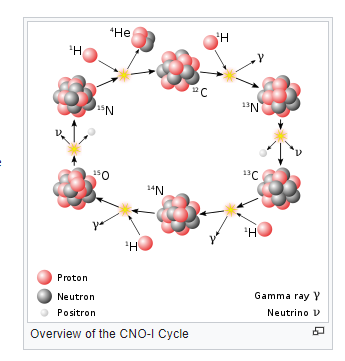Sidebar. The CNO cycle in stars’ nuclear fusion.
This is another process by which four protons (and two electrons, for charge balance) eventually combine to form a helium nucleus (an alpha particle), just as in the direct fusion described in the main text and in many reference articles. The difference from the “p-p” reaction is that the protons get captured by nuclei of carbon, nitrogen, and oxygen. These nuclei all regenerate in a cyclic process:

Wikipedia
These nuclei are thus catalysts: they speed up a reaction without being used up.
The CNO process needs these three heavier elements. It takes awhile for a small star with relatively low core temperature to create them. In the Sun with a low content of these heavier elements, or low metallicity, the CNO process provides only about 1% of the fusion power. This was verified by a very difficult detection of the high-energy neutrinos that it liberates. They were captured in a tank holding 280 tonnes of liquid hydrocarbon scintillator, in the Borexino experiment in Italy, which ran from 2016 to 2020. Electrons recoiling from collisions with the neutrinos created flashes of light that were detected by an array of 2212 sensitive photomultiplier tubes. The yield of flashes from the CNO-produced neutrinos was very low, just a “handful” per day per 100 tonnes of scintillator. It was a tour de force to retrieve this signal from a background of much stronger processes, by discriminating according to the energy.
Its neutrinos detected by Borexino expt. in 2020.
The existence of the process was proposed in the 1930s by Hans Bethe and Carl von Weizsäcker, when nuclear physics was nascent! Much more is known now, including that the CNO process provides a greater and greater fraction of fusion at higher stellar temperatures – i.e., in stars that are larger and are thus hotter.
More details can be found in a number of sources, ranging from rather detailed semi-popular presentations to advanced treatises.